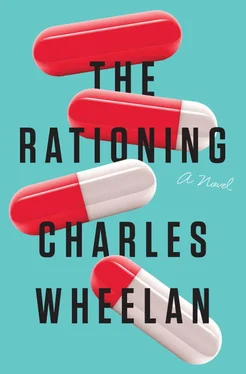Later that afternoon, the Communications Director released a statement proclaiming, “The President and First Lady have a rock-solid marriage,” and that any reports of extramarital affairs were “damaging and unsubstantiated.” Every press person immediately recognized the “nondenial denial,” which in media-speak means that the Communications Director had not denied the affair. He had merely described it as “damaging and unsubstantiated,” which means, “Yeah, it’s true, but my boss made me say something.” Over the next hour, the original South American affair story had fifty-two thousand hits, at which point the server went down. [6] Unfortunately, the former Chair of the Federal Reserve was also forced to deny that he had stolen two tons of gold, a rumor that dogs him to this day. As anyone who has served in Washington knows, these kinds of rumors can never be fully scrubbed away, no matter how outlandish they may be. I remember a college-educated friend telling me at a bar mitzvah years later, “Of course he denied stealing the gold. What else was he going to say? They never searched his house. Why not? Because all these guys are crooks. They’re in cahoots.” I considered telling him that it’s hard to get a search warrant based on an Internet rumor, but instead I just excused myself and went to the bar.
At about the same time, the Washington Post–USA Today reported that a “senior White House official” had “acknowledged the possibility” that the President was embroiled in a salacious sex scandal with “a member of the foreign diplomatic corps.” The genius of this misdirection was twofold. First, the nuclear story went away. (The cameras on the White House lawn were disassembled almost immediately and dispatched to camp out at various embassies across Washington.) Second, the mainstream media could pass off this sex scandal as real news, rather than just salacious gossip, because it involved a foreign diplomat, no doubt a spy. Obviously, the public has a right to know if the President is giving up national security secrets in exchange for sexual favors .
The news “analysts” quickly pieced the story together: the nuclear situation was just a cover for the President’s sexual misdeeds, which were so serious that he had assembled the top officials in the government, including the Speaker of the House and the Majority Leader, to discuss the possibility of his resignation. When this rumor frenzy was at its peak, the Communications Director leaked a photograph of a voluptuous, ethnically ambiguous, thirty-something woman to a Spanish-language television network. Much like that first iconic picture of Monica Lewinsky in the beret, this lovely Mediterranean or Arab or Hispanic woman became the face of the crisis. The press camped out at the twenty-plus embassies most likely to have a sexy spy with a vaguely olive complexion. In reality, the photo was computer-generated: a composite of several attractive celebrities, including a Lebanese jazz singer and a Brazilian soccer star, all melded together by a young computer whiz at the NSA. It was just an unfortunate coincidence that the computer-generated photo bore a stunning resemblance to Maria de la Campos Rivera, the head of the political section at the Colombian Embassy. Telemundo made the discovery, after which the press corps followed her doggedly. This turned out to be doubly tragic, since she was, in fact, having an affair with the married Cuban ambassador.
Roughly 60 percent of the American population still believes that the President was passing secrets through this Colombian mistress to the Cubans. That is ten times the number of Americans who can correctly locate Saudi Arabia on a world map.
BACK IN THE CABINET ROOM, WE STILL HAD NOT ADDRESSED the two most contentious issues: China and a possible “rationing plan” for Dormigen if we were to come up short. Before we plunged into that, the Chief of Staff updated us on assorted other small developments. The U.S. military had identified a stash of Dormigen in Germany, some forty thousand doses, that would be shipped back stateside immediately. The Canadians were monitoring their Dormigen usage on a daily basis; demand was falling short of their projections, so they shipped us a hundred thousand doses and projected they might be able to donate more in the coming days. The better news came from a working group at the Centers for Disease Control. Doctors there had lowered the likely fatality rate for those sickened by Capellaviridae to a range between 0.5 to 1.1 percent—which they described as “on par with a virulent strain of the flu.” The earlier estimates were based on data from victims who had not sought treatment. Those who showed up at a hospital were likely to do better, even without Dormigen. The CDC experts wrote in a short memo, “If victims are treated with fluids and antibiotics to deal with possible secondary infections, the likely fatality rate would be appreciably lower than our earlier estimate.” The report also noted that the pattern of fatalities would be similar to a bad flu: the very old, the very young, and the immunocompromised. Our intuition was confirmed: the early fatalities—clusters of college students and young, otherwise healthy men—were not the most vulnerable populations; they were the ones who were too stubborn to seek treatment.
Despite the protestations of the Strategist, we had abandoned “the number” and were now working with a “likely range” of deaths. Experts typically use confidence intervals when projecting outcomes. “The number” had been a bizarre and artificially precise construct. Still, I would emphasize how important it was in those early days to quantify the risk we were facing. We should be grateful to the Strategist, his personal foibles aside, [7] The Strategist was arrested in D.C. for solicitation eight months ago, and then again for the same offense three weeks later in Buffalo, New York. This made him a target for late-night comics, not merely for the prostitution arrest, but because it happened in Buffalo. He later made a compelling argument that prostitution should be legalized. (You can watch the YouTube video.) Like so many other things he argued, it was eminently sensible once you stripped the emotion away from the issue.
for his unwillingness to bury his head in the sand. The dominant sentiment in those early meetings was denial, which was the worst possible response.
Our range had settled at seventy-five thousand to a hundred and fifty thousand likely deaths. “Most of these people are going to die anyway,” the Strategist said.
“So are we,” the Acting HHS Secretary said.
“You know what I mean,” the Strategist said. “Most of these people are very sick to begin with. You read the CDC memo.”
“Not the very young,” the Acting HHS Secretary replied.
“Right,” the Strategist conceded. “But we can give them the Dormigen we have.”
The Chief of Staff interrupted the exchange. “Hold those thoughts,” she said. “We need to talk about China first.”
“That Dormigen offer is still on the table?” the Senate Majority Leader asked.
“Of course it is,” the President answered. “This is the best thing to happen to them since the British left Hong Kong.”
The Chief of Staff turned to the National Security Adviser. “Can you update us on where we are on the South China Sea Summit?”
“Yes, ma’am,” she replied crisply. “We can buy ourselves another two days. I’ve spoken to most of my counterparts in the other signatory nations. Rather than landing on the carrier at the beginning of the summit, they feel it would have the same effect if the President were to leave from a carrier after the agreement is signed.”
“We just do it at the end instead of the beginning,” the President said.
Читать дальше












